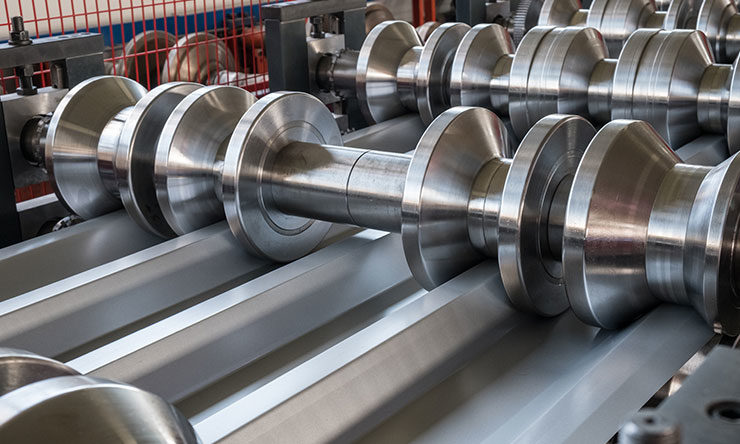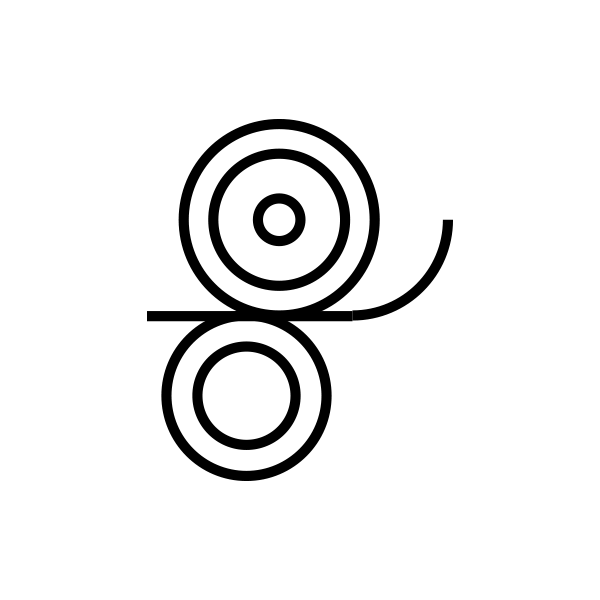Kloeckner’s roll forming service is capable of producing a wide variety of shapes and sizes in various grades to suit your needs.


Kloeckner offers large-scale roll forming capabilities throughout North America. Between our network of service centers and state-of-the-art machinery, we give our customers the chance to simplify their operations by ordering everything they need through one supplier. In addition, we’re proud to offer a complete solution for warehousing and end-to-end supply chain management.
Answer:
Rolling and roll forming are similar metal fabrication processes, but they have some differences.
Rolling is a metal forming process that involves the use of rolling mills to reduce the thickness or change the cross-sectional shape of a metal workpiece. In rolling, the metal workpiece is passed through two rotating rolls, which compress and deform the metal to the desired shape. Rolling is typically used to produce sheets, plates, and long bars with a uniform cross-section.
Roll forming, on the other hand, is a continuous metal forming process that uses a series of rolls to shape a metal strip into a desired cross-section. In roll forming, the metal strip is gradually shaped into the desired profile as it is fed through a series of forming stations, each of which contains a set of rolls that shape the metal in a specific way. Roll forming is typically used to produce long, complex metal profiles with a uniform cross-section.
In conclusion, rolling and roll forming are similar metal fabrication processes, but they differ in terms of the metal workpiece used, the number of rolls involved, and the desired end product. Rolling is used to produce metal sheets, plates, and long bars, while roll forming is used to produce long, complex metal profiles.
Answer:
Roll forming is used in a variety of industries including:
These are just a few examples of the many industries that use roll forming. The versatility of roll forming makes it a popular choice for producing metal parts for a wide range of applications.
Answer:
Steel plate, sheet, and coil can be roll formed. Steel is the most commonly roll formed metal, due to its strength and versatility. The specific grade of steel used for roll forming will depend on the application and desired properties of the final product.
The following are some common grades of steel that are used for roll forming:
These are just a few examples of the many grades of steel that can be roll formed. The specific grade of steel used will depend on the desired properties of the final product and the requirements of the application.
What is the difference between roll forming and plate rolling?
Answer:
Rolling and roll forming are similar metal fabrication processes, but they have some differences.
Rolling is a metal forming process that involves the use of rolling mills to reduce the thickness or change the cross-sectional shape of a metal workpiece. In rolling, the metal workpiece is passed through two rotating rolls, which compress and deform the metal to the desired shape. Rolling is typically used to produce sheets, plates, and long bars with a uniform cross-section.
Roll forming, on the other hand, is a continuous metal forming process that uses a series of rolls to shape a metal strip into a desired cross-section. In roll forming, the metal strip is gradually shaped into the desired profile as it is fed through a series of forming stations, each of which contains a set of rolls that shape the metal in a specific way. Roll forming is typically used to produce long, complex metal profiles with a uniform cross-section.
In conclusion, rolling and roll forming are similar metal fabrication processes, but they differ in terms of the metal workpiece used, the number of rolls involved, and the desired end product. Rolling is used to produce metal sheets, plates, and long bars, while roll forming is used to produce long, complex metal profiles.
Which industries is roll forming used in?
Answer:
Roll forming is used in a variety of industries including:
These are just a few examples of the many industries that use roll forming. The versatility of roll forming makes it a popular choice for producing metal parts for a wide range of applications.
Which types of steel plate, sheet, and coil are roll formed?
Answer:
Steel plate, sheet, and coil can be roll formed. Steel is the most commonly roll formed metal, due to its strength and versatility. The specific grade of steel used for roll forming will depend on the application and desired properties of the final product.
The following are some common grades of steel that are used for roll forming:
These are just a few examples of the many grades of steel that can be roll formed. The specific grade of steel used will depend on the desired properties of the final product and the requirements of the application.
AR500 steel is so hard and impact-resistant that manufacturers use it to make...
Aluminum is no doubt one of the most popular metals, shaping the capabilities...
Automotive aluminum has been around since aluminum was first produced. At the time,...
Lightweighting, a concept in the automotive industry, demands that all car parts be...

X
The Kloeckner Metals website uses modern technologies. Unfortunately, your browser doesn't support those technologies.
Download the latest version of one of these browsers to experience the site: